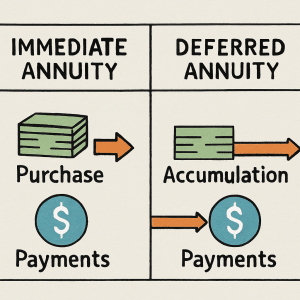Are Annuities Taxable?
Are annuities taxable? Yes—most annuities are subject to taxation at some point, but how they’re taxed depends on the type of annuity (qualified vs. non-qualified), how money comes out (payments, withdrawals, surrender, death benefits), and who receives the money (owner vs. beneficiary).
This guide explains the tax rules in plain English so you can avoid surprises and plan smarter. If you are considering purchasing an annuity, you can compare today’s best fixed annuity rates at our online marketplace.
Key takeaways
-
Earnings in annuities grow tax-deferred, but taxes apply when you take money out.
-
Qualified annuities (funded with pre-tax dollars) are generally fully taxable upon distribution.
-
Non-qualified annuities (funded with after-tax dollars) are taxed only on the earnings, not your original principal.
-
Beneficiaries pay ordinary income tax on the taxable portion of what they receive; annuities do not get step-up in basis like stocks.
Are annuity payments taxable?
Yes, annuity payments are taxable, but the taxable portion depends on your annuity type and how the IRS treats the cost basis.
- Non-qualified annuity payments: Part taxable, part non-taxable. Your after-tax contributions (basis) are returned tax-free, and the earnings portion is taxed as ordinary income. The IRS uses the “exclusion ratio” to determine how much of each payment is taxable vs. non-taxable over your life expectancy.
- Qualified annuity payments (e.g., from an IRA, 403(b), or qualified plan): Generally fully taxable as ordinary income because contributions were pre-tax and growth was tax-deferred.
- Reporting: You’ll typically receive Form 1099-R showing the taxable amount. The insurer calculates the exclusion ratio for non-qualified annuity payouts.
Pro tip: If you annuitize, you lock in the exclusion ratio across payments. If you take flexible withdrawals from a non-qualified annuity, the IRS applies “LIFO” (last-in, first-out), meaning earnings are distributed first and taxed sooner.
Are annuity withdrawals taxable?
Withdrawals from annuities are typically taxable to the extent of earnings.
- Non-qualified annuities: LIFO rules apply—earnings come out first and are taxed as ordinary income until all gains are exhausted. After that, you can withdraw your principal tax-free.
- Qualified annuities: Withdrawals are generally fully taxable.
- Early withdrawals: If you’re under age 59½, the taxable portion may be subject to a 10% IRS penalty in addition to ordinary income tax, unless an exception applies.
- Surrenders: If you fully surrender a non-qualified annuity, the gain (cash value minus basis) is taxed as ordinary income. No capital gains rates apply to annuity earnings.
Are annuity death benefits taxable?
When an annuity owner dies, the beneficiary may receive a death benefit or the remaining contract value. Tax treatment:
- Income taxes: Beneficiaries pay ordinary income tax on the annuity’s taxable portion (the earnings). The owner’s basis remains; annuities do not receive a step-up in basis like stocks or mutual funds.
- Timing matters: Beneficiaries can often choose options such as a lump sum, 5-year rule, or lifetime payout via a “stretch” (if permitted by contract/state rules). The election affects when and how much tax they pay each year.
- Estate taxes: If the decedent’s estate is large enough to be subject to estate tax, the annuity’s value may be included in the estate. This is separate from income tax.
are annuities taxable to beneficiaries?
Yes, beneficiaries are taxed on the annuity’s untaxed earnings upon receipt, at their ordinary income tax rates.
Key points:
- The beneficiary inherits the owner’s basis (no step-up).
- If paid as a lump sum, the taxable amount may be significant in one year.
- If paid over time, each payment includes a taxable portion. Non-qualified annuities may use an exclusion ratio; non-annuitized distributions usually follow LIFO.
- If the beneficiary is a spouse, they may have additional options (e.g., continuation of the contract as owner) depending on the insurer and contract terms.
are inherited annuities taxable?
Inherited annuities are taxable on gains, not on the original after-tax principal.
- Non-qualified inherited annuities: Beneficiaries owe ordinary income tax on earnings when received. They can often elect payout methods, which affect tax timing.
- Qualified inherited annuities (IRAs/403(b)s): Subject to inherited IRA/plan distribution rules (e.g., 10-year rule, life expectancy payments for eligible designated beneficiaries). Distributions are generally fully taxable as ordinary income.
- No capital gains rates: Annuity gains are not taxed at capital gains rates; they are taxed as ordinary income.
Are non-qualified annuities taxable?
Non-qualified annuities are funded with after-tax dollars. Taxation basics:
- Growth is tax-deferred: You do not pay tax annually on interest or credits inside the annuity.
- Taxes upon distribution: You pay ordinary income tax on the earnings portion. Your principal (basis) is not taxed again.
- Withdrawals vs. annuitization:
- Withdrawals follow LIFO—earnings first (taxable), then basis.
- Annuitization uses an exclusion ratio—each payment contains both taxable earnings and tax-free basis until the basis is fully recovered.
- 10% penalty: Applies to taxable distributions before age 59½ unless an exception applies.
Are Qualified annuities taxable?
Qualified annuities are inside tax-deferred retirement accounts (IRAs, 403(b), qualified plans) funded with pre-tax dollars or tax-deductible contributions.
- Generally fully taxable: Distributions are taxed as ordinary income because both contributions and earnings were tax-deferred.
- RMDs: If held in certain accounts, required minimum distributions (RMDs) may apply beginning at the applicable age (check current IRS rules; many cases start at age 73 depending on legislation).
- Roth annuities: If funded within a Roth IRA and held long enough to meet qualified distribution rules, payouts can be tax-free; however, ordering rules and qualification requirements apply.
Common scenarios and tax tips
- Partial withdrawals to supplement income: Expect taxable earnings first from non-qualified annuities; plan timing to manage tax brackets.
- Annuitization for lifetime income: Spreads taxable income over time via exclusion ratio (non-qualified), often simplifying budgeting.
- Beneficiaries and estate planning: Consider contract ownership, annuitant designation, and beneficiary options; spousal continuation may avoid immediate taxation.
- 1035 exchanges: You can exchange one non-qualified annuity for another via a tax-free 1035 exchange, preserving basis and deferring taxes. This does not avoid future taxes—just defers them.
- State taxes: In addition to federal income tax, state taxes may apply. Indiana residents should check state-specific rules and credits.
Frequently asked questions
-
Are annuity payments taxable?
Yes. Non-qualified annuity payments are partly taxable and partly a return of your after-tax principal based on the IRS exclusion ratio. Qualified annuity payments (e.g., from IRAs/403(b)s) are generally fully taxable as ordinary income.
-
Are annuity withdrawals taxable?
Typically yes. Non-qualified withdrawals follow LIFO (earnings first) and are taxed as ordinary income until gains are exhausted. Qualified withdrawals are generally fully taxable. Withdrawals before age 59½ may incur a 10% IRS penalty on the taxable portion.
-
Are annuity death benefits taxable?
Beneficiaries owe ordinary income tax on the untaxed earnings in the annuity when they receive payments or a lump sum. Annuities do not receive a step-up in basis at death like stocks; the decedent’s cost basis carries over.
-
Are annuities taxable to beneficiaries?
Yes, beneficiaries are taxed on the annuity’s taxable portion (earnings). They can often choose payout options (lump sum, period certain, lifetime), which affect timing and annual tax liability. Spouses may have additional options like contract continuation.
-
Are inherited annuities taxable?
Inherited annuities are taxable on gains. Non-qualified inherited annuities are taxed on earnings when distributed. Qualified inherited annuities follow inherited IRA/plan rules (e.g., 10-year rule) and distributions are generally fully taxable as ordinary income.
-
Are non-qualified annuities taxable?
Growth is tax-deferred, and taxes apply when money comes out. You owe ordinary income tax on the earnings portion; your original after-tax principal is not taxed again. Withdrawals use LIFO; annuitization uses the exclusion ratio.
-
Are qualified annuities taxable?
Yes. Since they are funded with pre-tax or tax-deductible dollars, distributions are generally fully taxable as ordinary income. RMDs may apply depending on account type and age. Roth annuities inside Roth IRAs can be tax-free if qualified.
Annuity Taxation Quiz
i
Sources & Citations
We regularly update this page and cite primary sources and regulator guidance:
- IRS.gov – Publication 575: Pension and Annuity Income. irs.gov/publications/p575
- FINRA – Annuities: What You Should Know. finra.org/investors/…/annuities
- The National Association of Insurance Commissioners (NAIC) – Buyer’s Guide to Fixed Deferred Annuities. naic.org/consumer/annuities
- IRS – Topic No. 412 Lump-Sum Distributions. irs.gov/taxtopics/tc412
- IRS – Publication 939, General Rule for Pensions and Annuities (exclusion ratio). irs.gov/publications/p939












